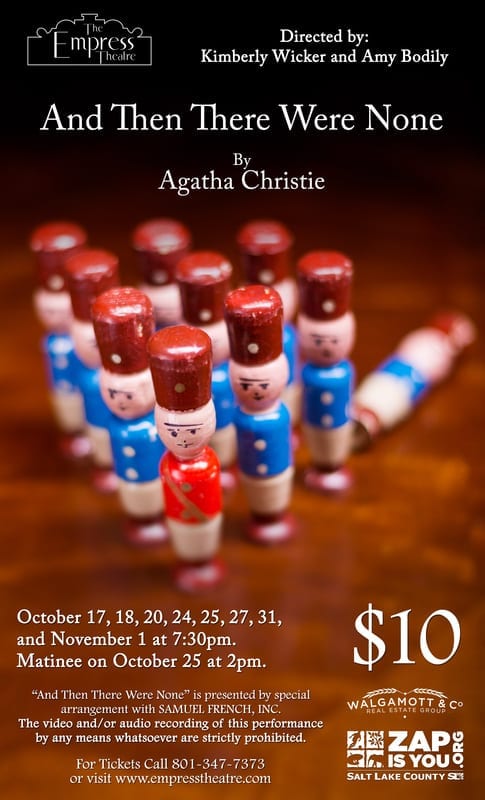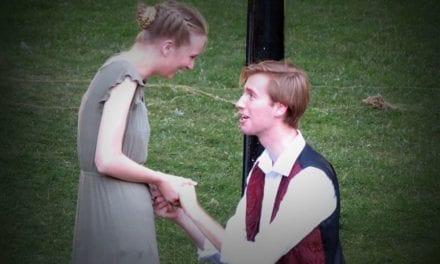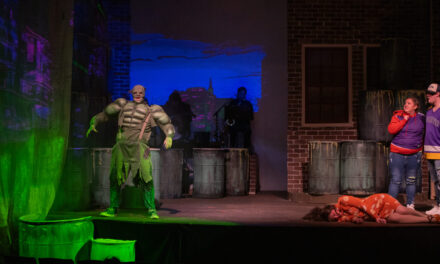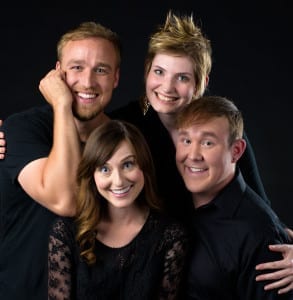MAGNA — When Agatha Christie‘s And Then There Were None opens, people are mysteriously invited to a mansion on an isolated island. Once they’re stranded there, they start dying one by one. Before long they figure out that the murderer is among them. As the play progresses, the nervousness and the hysteria increases as the characters turn against one another.
The Empress Theatre has chosen this production as their Halloween show, and the selection works well because of the ominous mood of play. Directors Kimberly Wicker and Amy Bodily have assembled a cast that physically resembles their characters, and they avoided using old age makeup, which would look unconvincing in the Empress. They also created excellent contrasts between some of the characters, such as Vera Claythorne (played by Jorden Cammack) and Emily Brent (played by Nancy Jensen), which showed the generational differences between them. I also enjoyed the different breakdowns that some of the characters had in the second act as their fear overtook them. Yet, the pacing for the first act was too slow, especially because for the first half hour the script is weighted down with a great deal of exposition.
Among the cast, Cammack and Jensen were my favorite performers. Cammack was elegant as Vera, and it was fascinating to watch her character gradually lose her composure as the characters around her were dying. Jensen’s stern demeanor provided wonderful conflict with the other characters, and her tirade punctuated the script with some volume and energy that, until then, the show lacked. Among the male cast members the best was Glen Carpenter as the judge Lawrence Wargrave. Carpenter was smooth amid the crisis, and he provided some guidance to other characters who were mired in their own panic.
However, other cast members did not impress me as much as Carpenter, Cammack, and Jensen. Many of the performers were difficult to understand because of a mix of accents and poor diction. I also thought that some of the Britishisms (like “wizard” or “beer and skittles”) sounded unnatural coming from these actors’ mouths. Other problems were more specific to certain performers. As Mrs. Rogers, Melanie Turner was difficult to believe because her line deliveries (with a few exceptions) did not sound like natural reactions to the rest of the dialogue. The mood swings of General Makenzie (played by Steve Hedman) also seemed too spontaneous, and I had trouble imagining him as being dangerous.
Amy Burton and Michele Brown‘s costumes for the female cast members were exquisite and perfect for the time period. The dowdy look of Emily Brant, created with frumpy clothes in earth tones, perfectly matched the character’s sterness. Vera’s fashionable late 1930’s clothes made her a sexy centerpiece to the mostly male cast. And Mrs. Rogers maid costume was wonderfully detailed and helped me understand quickly her social position compared to the other characters. Nevertheless, the men’s costumes were less impressive: most male characters wear 21st century items at some point, and some of the suits seemed too big for the actors. I would have liked to see, for example, Anthony Marston (played by Geoffrey Gregory) dressed in highly fashionable period attire to match the character’s wealthy, carefree lifestyle. The drab sweater vest he wore instead said little (if anything) about the character. (I did enjoy Gregory’s decision to make his character detached from the happenings around him, though.)
The set (designed by Tim Swensen) was well suited to the Empress Theatre’s thrust stage. The nicely painted fireplace and the pairs of French doors perfectly complemented the gorgeous set pieces to help create the mansion setting. However, the lighting (designed by Curtis Bailey) rarely contributed to the mood of the script. Some subtle lighting changes in color and intensity could have added to the ambiance that the directors were working so hard to create.
So, And Then There Were None has some excellent components (such as the Cammack’s performance, the women’s costumes, the set) and some disappointing aspects. This varying level of quality within a production is a common characteristic of the productions I have attended at the Empress Theatre. I can’t rave about this show, but I know that the Empress’s audience base will find something they like about this production.








